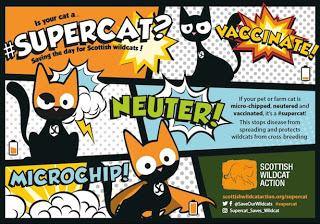 Action to save the enigmatic Scottish wildcat from extinction received a major boost this week with the news that more than 100 cats have been trapped during a recent neutering and vaccinating campaign.
Action to save the enigmatic Scottish wildcat from extinction received a major boost this week with the news that more than 100 cats have been trapped during a recent neutering and vaccinating campaign.Scottish Wildcat Action’s far-reaching Trap Neuter Vaccinate Return (TNVR) programme was carried out in its priority areas, including Morvern, Strathpeffer, Strathbogie, Northern Strathspey and the Angus Glens. These areas represent a total of 676 square miles (1750 square kilometres) of wildcat habitat.
Feral cats present a threat to wildcats by hybridising with them and diluting the gene pool. Since November last year three wildcat project officers, contractors and dozens of local volunteers helped to catch a total 115 cats.Of these, 82 were taken to a veterinary surgeon for treatment and later returned, 12 feral kittens were rehomed, seven cats were either pet cats or had been neutered previously and so were all released and two were possible wildcats that were released without neutering. The remaining 12 feral cats sadly tested positive for disease or were in such poor condition and had to be put to sleep on welfare grounds.
Scottish Wildcat Action is a national project supported by the Heritage Lottery Fund, which aims to halt the decline of this native species by 2020. It is led by Scottish Natural Heritage (SNH) and is a partnership of 20 organisations. The species’ conservation is an important feature of the Scottish Government’s 2020 Biodiversity Challenge.
In the wake of funding from the Heritage Lottery Fund, Scottish Wildcat Action spent 364 nights catching abandoned stray cats feral cats born in the wild and (with the permission of the owners) farm cats which are ‘mousers.’
SWA, working alongside the Scottish Society for the Prevention of Cruelty to Animals (SSPCA), caught 26 farm cats in just one location. Wild-living feral cats are considered the greatest risk to wildcats as they are more likely to live alongside wildcats, breeding with them and potentially transmitting diseases. But they are also the most difficult to catch and most of the effort by SWA staff and volunteers went towards catching these cats.
Roo Campbell, priority areas manager for Scottish Wildcat Action said: “Cross-breeding is diluting the wildcat gene pool and, as a result, they are losing their distinct adaptations to the harsh Scottish environment.
“Neutering and vaccinating domestic cats is the best way to protect them and we are very proud of our success this year. Eighty-two of the cats trapped were in the Strathbogie Wildcat Priority Area and catching such a high number will have an immediate impact on the risks to the wildcats there. But we are committed to this work and we have a lot more work to do before the wildcat is truly safe.”
Neutered domestic cats are released rather than culled because this may help wildcat populations recover in the long-term.
Dr Campbell explained: “If a wild-living cat is neutered and returned to the wild, it maintains a territory and keeps other feral cats from moving into the area. This allows wildcats to breed only with other wildcats.”
“We hope this will reduce the risk of disease from migrating feral cats, while over time a new generation of wildcats will replace the neutered feral cats.”
The project has been taking a break from TNVR over the spring and summer to avoid catching pregnant or nursing mothers. However, Scottish Wildcat Action is still calling on cat owners to help turn their pet cats into ‘supercats’ by having them neutered, vaccinated and micro-chipped.
Professor Anna Meredith, Personal Chair of Zoological and Conservation Medicine at The Royal (Dick) School of Veterinary Studies, said: “We must control the threat to wildcats of diseases like Feline Leukaemia, and Feline Aids. It is best to neuter and vaccinate your domestic cat as some diseases are spread when cats mate or fight with each other. Micro-chips help cats to be reunited with their owners if they get lost and alongside neutering this helps to reduce the flow of feral cats to the countryside.”
The supercat campaign was launched recently by wildlife filmmaker Gordon Buchanan using the Twitter hashtag #supercat. More information at www.scottishwildcataction.org/supercat

